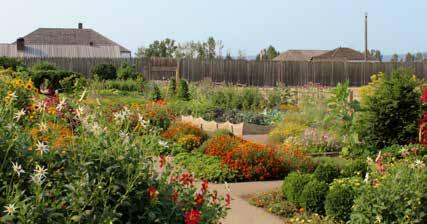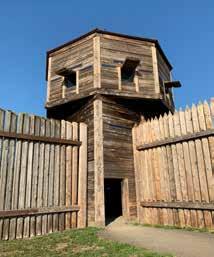
2 minute read
An English Garden
Planting a garden was one of the first things the Hudson’s Bay Company (HBC) did when they established Fort Vancouver. At its height, in the mid-1840s, the garden had expanded to eight acres and provided not only produce but also large numbers of flowering plants, shrubs, and fruit trees for the pleasure of the fort’s residents and visitors. This large gardening operation was symbolic of the power that the HBC exerted over the entire region and was representative of their extensive agricultural enterprises.
In 1836, American missionary Henry Spalding described the garden as”…about 5 acres laid out in good order, stored with almost every species of vegetables, fruit trees, and flowers.” His observations of the region’s farming potential, and those of other Americans, stimulated immigration from the eastern United States. In 1843 approximately 900 settlers made the journey to Fort Vancouver. By 1846 more than 8,000 settlers had arrived in the Oregon Country, leading to the end of HBC dominance.
Advertisement

The garden today is a small, interpretive representation of the larger historic garden. A dedicated cadre of volunteers and staff plant heirloom fruits, vegetables, herbs, and flowers to give a feeling for the abundance that was once here. Just as in the 1840s, the plants found in today’s garden provide produce for the fort’s kitchen and a place of beauty and rest for visitors.
The fort’s original orchard was characterized by full size, ungrafted apple trees with wide spacing. Today, this style of “farm orchard” has been recreated with seedlings of old English cider varieties and clones of Vancouver’s Old Apple Tree. Modern rendition, courtesy of the National Park Service.
The fort had a single bastion built into a corner wall of the fort. It held cannons that were mostly used for ceremonial purposes to welcome ships and trading vessels with an official greeting.

A minimum of four blacksmiths employed at a time were kept busy making tools like hammers, nails, axes, knives and even saw blades. They also made building items such as doorknobs, locks, hinges and window fasteners to kitchen implements such as pots and kettles to cooking spoons and hooks to hang things on.

The carpenter shop was in constant demand for doors, window casings, furniture, wagons and the planning of other buildings.
Today expert carpenters in period dress using only the tools and expertise of the time continue to make everything from tables, benches, doors and floors to wheelbarrows and 18th century toys.

Men and women ate separately but elegantly at the Factor House.
Animal pelts, primarily beaver brought to the fort were kept in “stores”, or warehouses. The furs were inventoried, cleaned, and pressed into bales before being shipped. In 1843, more than 61,000 furs were sent to England with each beaver pelt valued at about $170 of today’s value. The fur trade was a profitable business.
Meals for the Chief Factor, officers, family and guests were prepared in a separate kitchen located next to the Factor house.
Separate from the cookhouse was the bakehouse used for baking bread and mountains of sea biscuits that would be used for sailors, trapping brigades, other forts and for commercial sale.
The Indian trade shop was a busy place for purchases of all kinds.








